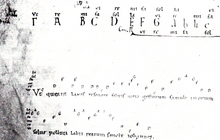John's hymn
The John Hymn is a hymn to John the Baptist , which is traditionally attributed to Paulus the deacon (approx. 720–799). The hymn begins with the words Ut queant laxis . It is written in Sapphic stanzas and is a fine example of Leonine verse with six lifts ( hexameters ).
The Roman Catholic breviary for the feast of the birth of John the Baptist on June 24th divides this hymn into three parts. She assigns the first part “Ut queant laxis” to Vespers , the second part “Antra deserti teneris sub annis” to Matutin , and the third part “O nimis felix, meritique Celsi” to Laudes .
Significance in music history

With the help of this hymn, Guido von Arezzo taught his singing students to memorize notes. For this he created a suitable melody. He probably invented the melody himself, or he may have used an existing melody and redesigned it. The melody was so suitable because the first six half-lines ( hemistichiae ) begin one after the other with the notes of a six-step scale ( hexachord ). The first stanza reads:
Ut queant laxis / re sonare fibris
mi ra gestorum / fa muli tuorum
sol ve polluti / la bii reatum
Sancte Iohannes .
The initial syllables of the first six half lines became the solmization ssyllables ut , re, mi, fa, sol, la. The seventh degree of the scale, which exceeds the hexachord chosen by Guido and does not appear in his melody, was added later. Its name is si - formed from the first two letters in the last verse ( S ancte I ohannes). In the 17th century Otto replaced Gibelius ut with do .
Literal translation of the first verse: "On that students with loose vocal cords may like to bring to sound the wonders of your deeds, solve the fault of the stained lip, holy John." This is an allusion to Zechariah , who according to the report of Luke's Gospel ( Lk 1.22 EU ) had become mute and his tongue was loosened again when his son Johannes was born. For the same reason John the Baptist (before St Cecilia succeeded him ) was the patron saint of church music .
In an old German translation, the tones of the G scale are used:
G ib that with loose / A APPROACH can sing,
H err, what you did, / C hear your pupils,
D ass you without blemish / E lead our lips,
Saint John.
Individual evidence
- ^ Hugh Henry: Ut Queant Laxis Resonare Fibris . In: Catholic Encyclopedia , Volume 15, Robert Appleton Company, New York 1912.
- ↑ Wolfgang Hirschmann : Guido von Arezzo. In: Ludwig Finscher (Hrsg.): The music in past and present . Second edition, personal section, volume 8 (Gribenski - Hilverding). Bärenreiter / Metzler, Kassel et al. 2002, ISBN 3-7618-1118-7 , Sp. 224 ( online edition , subscription required for full access).
- ↑ In New Grove (1989) the following can be read about it: “Although the text of the hymn Ut queant laxis is found in an MS of c800 (I-Rvat Ottob. 532) and by an old tradition is ascribed to Paulus Diaconicus, the melody in question was unknown before Guido's time and never had any liturgical function. It is probable that Guido invented the melody as a mnemonic device or reworked an existing melody now lost. "
